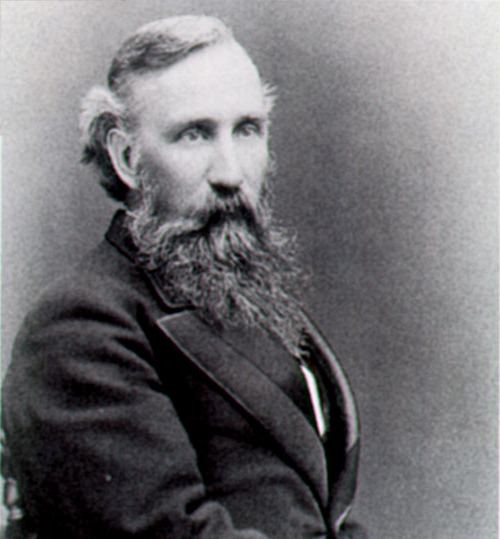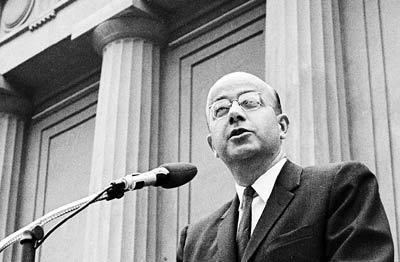Name Clark Kerr | Spouse Catherine Kerr | |
 | ||
Born May 17, 1911Stony Creek, Pennsylvania, USA ( 1911-05-17 ) Alma mater Swarthmore CollegeStanford UniversityU.C. Berkeley Profession Economist, educator, administrator Institutions University of WashingtonUniversity of California, BerkeleyUniversity of California Education London School of Economics and Political Science Books The uses of the university, The Gold and the Blue: A P, Higher education cannot es, Troubled times for American, The future of industrial societies Similar People Seymour Martin Lipset, Martin A Trow, John Ashcroft | ||
Clark kerr and the californian model of higher education
Clark Kerr (May 17, 1911 – December 1, 2003) was an American professor of economics and academic administrator. He was the first chancellor of the University of California, Berkeley, and twelfth president of the University of California.
Contents
- Clark kerr and the californian model of higher education
- 2014 kerr lecture clark kerr and the californian model of higher education
- Early years
- UC Berkeley
- University of California regents
- Student protests
- Blacklisting
- Personal life
- Legacy and honors
- References

2014 kerr lecture clark kerr and the californian model of higher education
Early years

Kerr was born in Stony Creek, Pennsylvania to Samuel William and Caroline (Clark) Kerr, and earned his A.B. from Swarthmore College in 1932, an M.A. from Stanford University in 1933, and a Ph.D. in economics from UC Berkeley in 1939. In 1945, he became an associate professor of industrial relations and was the founding director of the UC Berkeley Institute of Industrial Relations.
U.C. Berkeley
Soon after the beginning of the Second Red Scare (the McCarthy era), in 1949, the Regents of the University of California adopted an anti-communist loyalty oath to be signed by all University of California employees. Kerr signed the oath, but fought against the firing of those who refused to sign. Kerr gained respect from his stance and was named UC Berkeley's first chancellor when that position was created in 1952. As chancellor, Kerr oversaw the construction of 12 high-rise dormitories. In September, 1953, President Dwight D. Eisenhower appointed him to the Commission on Intergovernmental Relations.
University of California regents
In 1958, Kerr was the Regents' choice to lead the entire university system. His term as UC president saw the opening of campuses in San Diego, Irvine, and Santa Cruz to accommodate the influx of baby boomers. Faced with a dramatic increase of students entering college, Kerr helped establish the now much-copied California system of having the handful of University of California campuses act as 'top tier' research institutions, the more numerous California State University campuses handle the bulk of undergraduate students and the very numerous California Community College campuses provide vocational and transfer-oriented college programs to the remainder. A Mother Jones article mentioned that Kerr's achievements in this field earned him international acclaim.
In 1959, Kerr along with Chancellor Glenn T. Seaborg helped found the Berkeley Space Sciences Laboratory.
Student protests
Controversy exploded in 1964 when Berkeley students led the Free Speech Movement in protest of regulations limiting political activities on campus, including Civil Rights advocacy and protests against the Vietnam War. It culminated in hundreds of arrested students at a sit-in. Kerr’s initial decision was to not expel University of California students that participated in sit-ins off campus. That decision evolved into reluctance to expel students who later would protest on campus in a series of escalating events on the Berkeley campus in late 1964. Kerr was criticized both by students for not agreeing to their demands and by conservative UC Regent Edwin Pauley and others for responding too leniently to the student unrest.
Blacklisting
In 2002, the FBI released documents used to blacklist Kerr as part of a government campaign to suppress subversive viewpoints at the University. This information had been classified by the FBI and was only released after a fifteen-year legal battle that the FBI repeatedly appealed up to the Supreme Court, but agreed to settle before the Supreme Court decided on hearing the matter. President Lyndon Johnson had picked Kerr to become Secretary of Health, Education and Welfare but withdrew the nomination after the FBI background check on Kerr included damaging information the agency knew to be false.
Edwin Pauley approached CIA Director John McCone (a Berkeley alum and associate) for assistance. McCone in turn met with FBI Director J. Edgar Hoover. Hoover agreed to supply Pauley with confidential FBI information on "ultra-liberal" regents, faculty members, and students, and to assist in removing Kerr. Pauley received dozens of briefings from the FBI to this end. The FBI assisted Pauley and Ronald Reagan in painting Kerr as a dangerous "liberal."
Kerr's perceived leniency was key in Reagan's election as Governor of California in 1966 and in Kerr's dismissal as president by the university’s Board of Regents in 1967. Shortly thereafter, Kerr's old friend Thomas M. Storke insisted that Kerr should be allowed to participate, as previously scheduled, in the dedication of a building on the Santa Barbara campus in Storke's honor. At the dedication ceremony, Kerr looked each of the Regents in the eye as he stated that he had left the presidency of the university just as he had entered it: "fired with enthusiasm."
Kerr’s second memoir, The Gold and the Blue: A Personal Memoir of the University of California, 1949-1967 Volume Two: Political Turmoil details what he refers to as his greatest blunders in dealing with the Free Speech Movement that ultimately led to his firing.
Following his dismissal, Kerr served on the Carnegie Commission on Higher Education until 1973 and was chairman of the Carnegie Council on Policy Studies in Higher Education from 1974 to 1979.
Kerr also served as Chairman, 1984 USPS National Agreement arbitration chairman—and then joined the USPS panel of national contract arbitrators.
Personal life
Kerr was married to Catherine "Kay" Spaulding on Christmas Day, 1934. Kay along with friends founded the Save San Francisco Bay Association in 1961, which became Save the Bay. The couple had three children; Clark E., Jr., Alexander, and Caroline Gage. He died in his sleep on December 1, 2003 in El Cerrito, California, following complications from a fall.
Legacy and honors
There are Kerr Halls on the campuses of U.C. Davis, U.C. Santa Barbara, U.C. Santa Cruz, and U.C. Berkeley. Additionally a second campus for UC Berkeley located near the first campus is named after him – The Clark Kerr Campus.
The Berkeley facility is located a few blocks from the main campus, and includes residences and sports practice facilities. The Spanish-style residential complex houses 700 students and features landscaped gardens and a conference center. It was previously the site of the California School for the Deaf and Blind, and was acquired by the University after a court battle. (The University was not a party to the case. It was offered the site after the Schools for the Deaf and Blind relinquished it to the State as surplus property.)
The Clark Kerr Medal is named in his honor.
Another legacy was his wit—after writing a serious book, The Uses of the University, Kerr surprised an audience with this riposte--"The three purposes of the University?--To provide sex for the students, sports for the alumni, and parking for the faculty."
And after being fired by California's Governor (and future United States President) Ronald Reagan, Kerr responded that he left office as he had begun—"Fired with enthusiasm".
